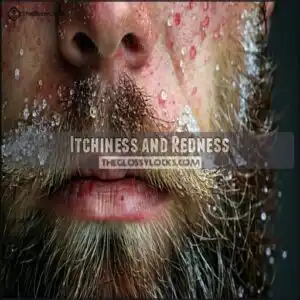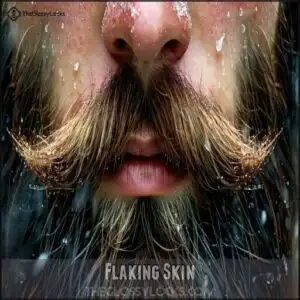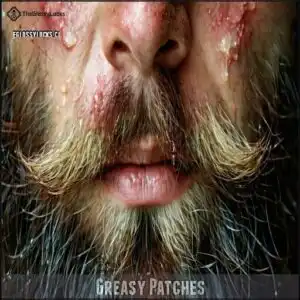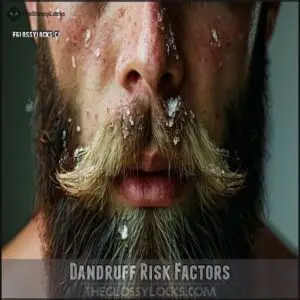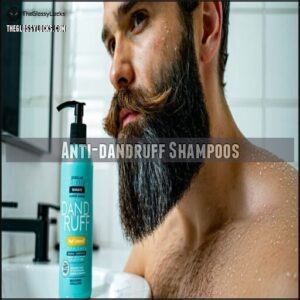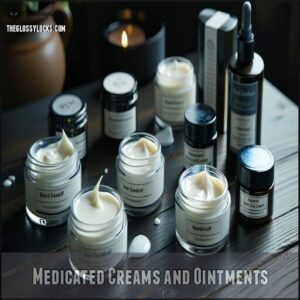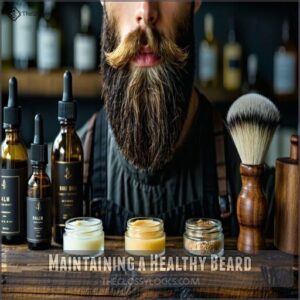This site is supported by our readers. We may earn a commission, at no cost to you, if you purchase through links.

When you’re stressed, your body ramps up oil production, which feeds a fungus called Malassezia. This little guy thrives and irritates your skin, causing flakes, redness, and itchiness.
Stress also speeds up skin cell turnover, leaving more dead cells to pile up in your beard. Add in factors like dry skin or improper washing, and dandruff’s got a field day.
The good news? Managing stress through exercise, sleep, and relaxation can help. Pair that with proper beard care, and you’ll be back to flake-free confidence in no time.
Table Of Contents
- Key Takeaways
- Stress Causes Beard Dandruff
- Beard Dandruff Symptoms
- Dandruff Risk Factors
- Managing Stress and Dandruff
- Preventing Beard Dandruff
- Treating Beard Dandruff
- Maintaining a Healthy Beard
- Frequently Asked Questions (FAQs)
- Why does my beard dandruff flare up?
- Does dandruff lead to baldness?
- How does stress affect dandruff?
- What is beard dandruff?
- How to get rid of dandruff with Beard oil?
- Can dandruff flakes show up in your beard?
- Can stress-induced beard dandruff worsen over time?
- How does stress impact beard skin hydration levels?
- Are certain stress types more likely to trigger dandruff?
- Does stress-related dandruff differ from other types?
- Conclusion
Key Takeaways
- Manage your stress with exercise, sleep, and relaxation techniques to control oil production and prevent Malassezia overgrowth.
- Keep your beard clean by washing 2-3 times a week with a gentle anti-dandruff shampoo and avoid overwashing to maintain balance.
- Hydrate your beard with oils like jojoba or argan to moisturize the skin and reduce flakiness caused by dryness.
- Exfoliate your beard weekly to remove dead skin and unclog pores, preventing dandruff buildup and irritation.
Stress Causes Beard Dandruff
When stress hits, it’s more than just a mental burden—it can trigger beard dandruff by ramping up oil production and disrupting your skin’s delicate balance.
Your beard becomes a breeding ground for Malassezia, the yeast responsible for those pesky white flakes, turning your facial hair into an itchy, irritating landscape.
Hormonal Changes
Your stress’s hormonal rollercoaster can trigger beard dandruff faster than you’d expect.
Hormonal changes disrupt your skin’s delicate balance, creating the perfect storm for flaking and irritation.
Key dandruff triggers include:
- Cortisol spikes increasing oil production
- Weakened immune system responses
- Accelerated skin cell turnover
- Hormonal fluctuations disrupting skin health
- Stress-induced sebum imbalances
Manage these changes to reclaim your beard’s health.
Oil Production Increase
When hormonal shifts hit, your body’s sebum production goes into overdrive. Your beard becomes a breeding ground for oil buildup, transforming from stylish to sticky.
Let’s break down how stress hijacks your skin’s natural balance.
| Trigger | Impact |
|---|---|
| Hormones | Increased Sebum |
| Stress | Oil Overproduction |
| Diet | Skin Sensitivity |
| Environment | Beard Irritation |
Beard dandruff doesn’t stand a chance when you understand its oily origins.
Skin Cell Turnover
When stress disrupts your skin’s turnover rate, it can throw a wrench in cell maturation.
Stress scrambles skin turnover, leaving your beard battling flakes and irritation like a storm in a teacup.
Your skin’s natural shedding process goes haywire, creating an unbalanced environment beneath your beard.
Exfoliation becomes paramount in managing stress dandruff, helping reset skin regeneration and improve product penetration for healthier facial hair.
Addressing this often requires proper shampooing frequency to maintain scalp balance.
Malassezia Overgrowth
As skin cells rapidly turn over, your beard becomes a playground for Malassezia, a microscopic yeast that thrives on sebum breakdown.
This fungal imbalance triggers skin irritation when stress amplifies oil production.
The result? A beard microbiome gone wild, with Malassezia multiplying and producing oleic acid that leads to beard dandruff, turning your facial hair into an itchy battleground.
Beard Dandruff Symptoms
If you’re experiencing an itchy, irritated beard with white flakes and greasy patches, you might be dealing with beard dandruff triggered by stress.
Understanding these telltale symptoms can help you tackle the underlying causes and restore your beard’s health.
Itchiness and Redness
Battling an itchy, red beard can feel like wrestling a prickly bear.
Inflammation severity often stems from stress-triggered skin irritation, making your facial hair a hotspot for discomfort.
Scratching only worsens the situation, potentially damaging delicate beard skin and exacerbating underlying causes.
Addressing this may require understanding seborrheic dermatitis symptoms to properly care for your beard.
Symptom relief requires understanding your beard’s unique reactions and implementing gentle, targeted care strategies.
Flaking Skin
When beard dandruff’s itchiness fades, flaky skin takes center stage. Those white specks cascading through your facial hair aren’t just annoying—they’re a telltale sign of underlying skin drama.
- Beard flakes signal disrupted skin cell turnover
- Dryness severity varies with individual skin types
- Seasonal changes amplify skin hydration challenges
- Stress triggers unexpected exfoliation methods
- Product sensitivity can worsen flaking episodes
Understanding these signals helps you regain control.
Greasy Patches
When stress kicks into overdrive, your sebum production goes haywire, leaving greasy patches in your beard.
These sticky zones signal a yeast connection with beard dandruff, triggered by washing imbalance and product residue.
Your skin’s hydration suffers, creating an oily playground where sebum buildup thrives, making your facial hair look like an unwashed mop.
White or Yellow Scales
White or yellow scales in your beard can signal dandruff severity. These flakes often cluster around oily areas, like the chin or jawline.
Causes include:
- Scale Severity: Linked to Malassezia overgrowth.
- Scale Location: Found in warm, oily spots.
- Scale Color: White or yellow, indicating oil buildup.
- Underlying Cause: Stress or improper care.
- Treatment Options: Use antifungal shampoos or gentle cleansers.
Dandruff Risk Factors
Your risk of beard dandruff increases with factors like oily skin, existing skin conditions, and improper washing habits.
Age and gender also play a role, as men and younger individuals are more prone to this issue.
Oily Skin Types
Oily skin can make beard dandruff worse by increasing sebum production, which feeds dandruff-causing fungi.
Enlarged pores trap oil and dead skin, creating flakes.
Improper washing frequency or product buildup amplifies the issue.
Look for specific ingredients like tea tree oil or zinc pyrithione in cleansers to manage beard oil production.
| Factor | Impact on Beard Dandruff | Solution |
|---|---|---|
| Sebum Production | Feeds fungi, causes flaking | Use oil-balancing cleansers |
| Enlarged Pores | Traps oil, dead skin | Exfoliate regularly |
| Product Buildup | Irritates skin | Use lightweight products |
| Washing Frequency | Too much/little worsens it | Wash 2-3 times weekly |
| Specific Ingredients | Control oil, fight fungi | Choose antifungal products |
Pre-existing Skin Conditions
Skin conditions like eczema, psoriasis, and rosacea can worsen beard dandruff.
Seborrheic dermatitis, often tied to sensitive skin, thrives when these issues flare up. Eczema triggers inflammation, while psoriasis impacts skin cell turnover, creating flakes. The rosacea connection adds redness and irritation.
Managing these dermatitis types is key to controlling beard dandruff, especially during stressful periods that aggravate symptoms.
Using antifungal shampoos can help combat fungal infections that exacerbate these conditions. Eczema triggers inflammation, while psoriasis impacts skin cell turnover, creating flakes. Sensitive skin
Improper Washing
Improper beard washing can worsen beard dandruff. Overwashing strips natural oils, while infrequent washing leads to product buildup and clogged pores.
Follow these tips:
- Use a gentle beard shampoo to avoid harsh chemicals.
- Wash 2-3 times weekly, adjusting frequency based on skin type.
- Opt for lukewarm water—hot water dries skin, increasing flakiness.
Maintain consistent beard hygiene!
Age and Gender
Improper washing isn’t the only culprit—age and gender play a big role in beard dandruff.
Hormonal influence makes men more susceptible, especially during adolescence when oil production peaks. Beard dandruff stress anxiety often flares in your 30s to 60s.
Women? Less affected due to gender differences in oil glands.
Thankfully, symptoms decline with age.
| Factor | Impact on Beard Dandruff | Key Insight |
|---|---|---|
| Hormonal Influence | Triggers excess oil production | Peaks in adolescence |
| Male Susceptibility | Higher due to oilier skin | Linked to sebaceous gland activity |
| Age Decline | Symptoms lessen after 50 | Lower oil production over time |
Managing Stress and Dandruff
Stress can trigger beard dandruff by increasing oil production and irritating your skin.
Managing stress with a healthy diet, regular exercise, and proper relaxation techniques can help keep your beard and skin in balance.
Healthy Diet and Exercise
A healthy diet and exercise can work wonders for managing beard dandruff and stress. Focus on nutrient-rich foods and staying hydrated to support skin health. Incorporate regular physical activity to reduce stress and improve circulation.
- Dietary changes: Add vitamin-rich foods like leafy greens and nuts.
- Hydration importance: Drink plenty of water daily.
- Exercise benefits: Boost mood and skin renewal.
Quality Sleep and Relaxation
How’s your sleep hygiene?
Quality rest isn’t just about feeling refreshed—it helps manage stress hormones that can trigger beard dandruff.
Prioritize relaxation techniques like deep breathing or reading before bed to ease stress and anxiety. A consistent sleep routine supports mental wellbeing, promoting stress relief.
Small lifestyle changes, like limiting screen time, can improve sleep and reduce beard-related flare-ups.
Stress Reduction Techniques
Stress can sneak up on you, fueling beard dandruff.
Stress silently fuels beard dandruff, turning your once-pristine facial hair into an itchy, flaky battlefield.
Tackle it with these stress reduction techniques:
- Mindfulness Practices: Try meditation or deep breathing for instant stress relief.
- Exercise Benefits: Regular workouts balance hormones and improve mood.
- Relaxation Methods: Explore yoga or aromatherapy to unwind.
- Lifestyle Changes: Manage stress and anxiety with better sleep hygiene and diet management.
Stay consistent!
Preventing Beard Dandruff
Preventing beard dandruff starts with keeping your skin clean, hydrated, and free of buildup.
By sticking to a routine of regular exfoliation, gentle washing, and proper moisturizing, you can minimize flakes and irritation effectively.
Regular Exfoliation
Exfoliating your beard is like hitting the reset button for your skin.
It clears dead cells, prevents clogged pores, and reduces beard dandruff.
Use a gentle scrub or chemical exfoliator weekly, adjusting exfoliation frequency for sensitive skin.
DIY scrubs with sugar or oats work wonders too.
Many users find a beard exfoliation scrub beneficial for this purpose.
Improves hydration
Gentle Beard Wash
After exfoliating, a gentle beard wash tackles beard dandruff by keeping oil, dead skin, and stress rash triggers in check.
Stick to these basics for success:
- Choose wisely: Look for sensitive-skin-friendly products with soothing ingredients—argan oil or chamomile work great.
- Nail the technique: Massage lightly without scrubbing harshly.
- Find balance: Wash 2-3 times weekly to avoid dryness.
A quality product can promote healthy beards.
Moisturizing and Conditioning
Don’t skimp on hydration—the foundation of proper beard care.
Use beard oils or balms designed for moisture and itch control. Focus on ingredients like argan or jojoba for balanced hydration.
Massage oil into damp hair using circular techniques for absorption.
Consider using beard conditioning products for suitable beard health.
| Benefit | Product | Key Ingredient | Daily Use? |
|---|---|---|---|
| Hydration | Beard Oil | Jojoba | Yes |
| Itch Relief | Beard Balm | Argan | Yes |
| Soft Beard | Conditioner | Shea Butter | Optional |
| Anti-Dandruff | Moisturizer | Aloe Vera | Yes |
Treating Beard Dandruff
You can tackle beard dandruff effectively with the right approach and consistent care. Use medicated shampoos, creams, or natural treatments to target the root causes and restore healthy skin.
Anti-dandruff Shampoos
When beard dandruff strikes, a medicated shampoo can work wonders.
Look for one with ingredients like pyrithione zinc or selenium sulfide to reduce flakes.
Here’s how:
- Apply shampoo directly to your dry beard.
- Let it sit for five minutes.
- Rinse thoroughly to guarantee no residue remains.
- Repeat regularly for a healthier, flake-free beard.
Medicated Creams and Ointments
Treating beard dandruff often involves antifungal medications like ketoconazole or ciclopirox creams.
For flare-ups, a cortisone solution or hydrocortisone cream can help, but limit topical steroid treatment to 10 days monthly to avoid side effects like skin thinning.
Prescription strength options may be necessary for severe cases.
Proper application techniques guarantee effectiveness—massage gently into the skin and follow usage guidelines.
Some shampoos contain pyrithione zinc to fight flakes. Antifungal medications
Home Remedies and Natural Treatments
For natural remedies, aloe vera soothes irritation, while tea tree oil fights fungi—just dilute it to avoid rashes.
Coconut oil moisturizes and tackles dandruff with its antifungal properties.
Apple cider vinegar, though anecdotal, may help balance skin pH.
Baking soda exfoliates gently, reducing flakes.
Combine these with stress management and beard oil for a healthier, flake-free beard.
Maintaining a Healthy Beard
Keeping your beard healthy means finding the right balance between washing, moisturizing, and grooming.
By protecting your skin and adjusting your care routine as needed, you can prevent issues like dandruff and keep your beard looking its best.
Balanced Washing and Moisturizing
After addressing treatments, focus on balanced washing and moisturizing to keep beard dandruff at bay.
Adjust your washing frequency based on skin type—oily needs more, dry less.
Use a beard wash designed for hydration, and pat dry gently to avoid irritation. Regular beard moisturizing locks in hydration, reducing flakes caused by beard dandruff stress.
Tailor your routine as needed.
Trimming and Grooming
Regular beard trimming keeps your style sharp and prevents oil buildup that worsens beard dandruff.
Use quality tools, and clean them often to avoid irritation.
Follow current style trends, but prioritize comfort over fashion.
Grooming frequency depends on your beard’s growth rate; weekly maintenance works for most.
After trimming, apply a nourishing product to hydrate and soothe the skin underneath.
Protecting The Skin and Beard
Protecting your skin and beard starts with hydration importance—keep the skin beneath your beard moisturized to prevent dryness and flaking.
Opt for product selection wisely, choosing gentle cleansers and beard oils free of harsh chemicals.
Shield your beard from environmental protection challenges like cold winds by applying balms.
Gentle cleansing and a healthy lifestyle guarantee lasting beard health and reduce beard itch.
Monitoring and Adjusting Care Routine
After protecting your skin and beard, keep an eye on how your beard care routine performs.
Track symptoms like flaking or redness to spot what works.
Adjust washing frequency for seasonal changes or product sensitivity. Small tweaks, like switching products or hydrating more, can improve routine effectiveness.
A consistent beard maintenance routine helps with stress anxiety and beard dandruff prevention.
Frequently Asked Questions (FAQs)
Why does my beard dandruff flare up?
Your beard dandruff flares up due to factors like excess oil, stress, or seasonal changes.
These create an ideal environment for yeast growth, irritating your skin and causing flakes.
Adjust care routines to manage triggers effectively.
Does dandruff lead to baldness?
Ironically, dandruff itself doesn’t cause baldness, but constant scratching can damage hair follicles, leading to thinning.
Keep your scalp or beard healthy with proper care to avoid irritation and potential long-term hair issues.
How does stress affect dandruff?
Stress kicks your oil glands into overdrive, creating the perfect playground for dandruff-causing yeast.
It triggers inflammation too, making itchiness and flaking worse.
Managing stress helps keep your skin calm and dandruff at bay.
What is beard dandruff?
Think of it as snow on your beard—not the festive kind.
Beard dandruff happens when skin beneath your facial hair flakes due to dryness, excess oil, or fungal growth, causing itching, redness, and irritation.
How to get rid of dandruff with Beard oil?
Apply beard oil daily after washing to moisturize and reduce flakiness.
Choose oils with ingredients like argan or jojoba, as they hydrate skin and beard hair, helping balance oil production while soothing irritation.
Can dandruff flakes show up in your beard?
Yes, dandruff flakes can show up in your beard.
They result from dry skin, oil buildup, or seborrheic dermatitis.
Proper washing, moisturizing, and using anti-dandruff products can help you manage and prevent flakes effectively.
Can stress-induced beard dandruff worsen over time?
Picture an itchy, flake-filled beard that worsens day by day.
Stress spikes oil production, feeding dandruff-causing yeast.
Left unchecked, the cycle deepens, leading to itchier, redder skin and persistent flakes.
Address it early for lasting relief.
How does stress impact beard skin hydration levels?
Stress reduces your skin’s ability to retain moisture, leaving beard skin dehydrated.
It triggers excess oil production, creating a cycle of dryness and greasiness.
These shifts weaken skin, making it prone to irritation and dandruff.
Are certain stress types more likely to trigger dandruff?
Studies show chronic stress can increase oil production by up to 62%, creating the perfect breeding ground for dandruff-causing yeast.
Emotional stressors like anxiety or worry are particularly notorious for triggering flare-ups, affecting skin health.
Does stress-related dandruff differ from other types?
Stress-related dandruff often flares up due to increased oil production, creating a perfect environment for yeast growth.
Unlike other types, it’s frequently linked to lifestyle factors, making stress management a key part of treatment.
Conclusion
An old saying goes, "Prevention is better than cure."
Regarding beard dandruff caused by stress, managing your stress levels is key.
Exercise regularly, get quality sleep, and practice relaxation techniques to keep your body and mind balanced.
Pair this with proper beard care, like exfoliating, washing, and moisturizing, to keep flakes at bay.
If dandruff persists, consider anti-dandruff shampoos or medicated treatments.
With consistent care, you can maintain a healthy, flake-free beard confidently.


